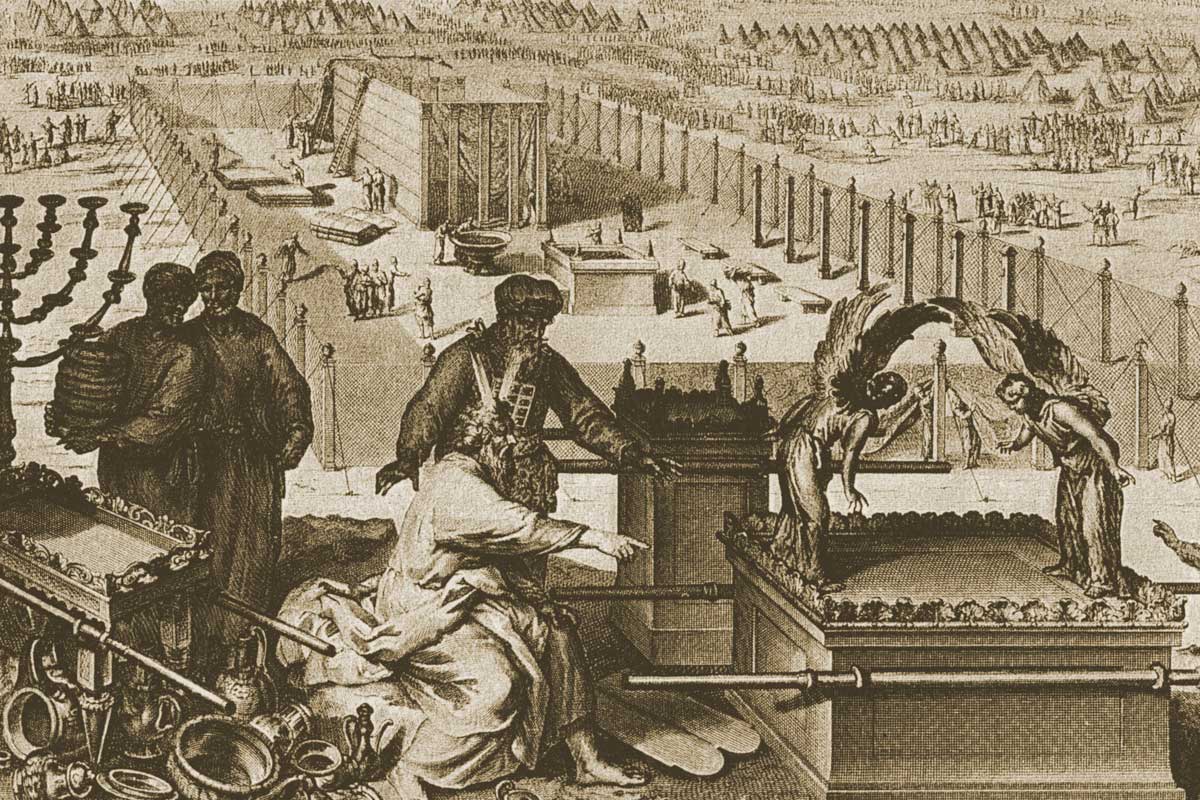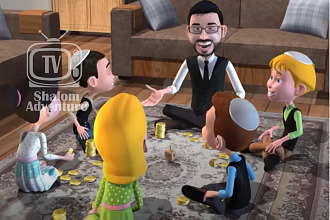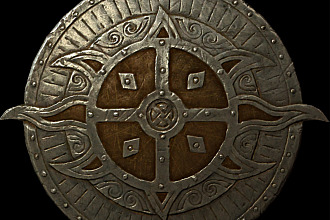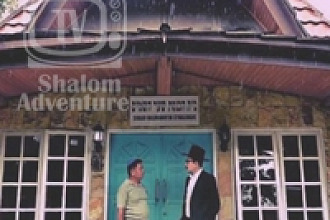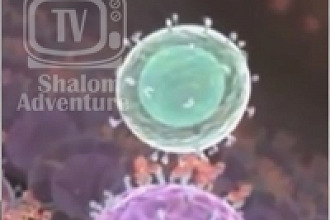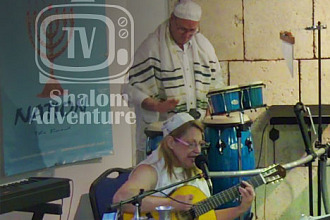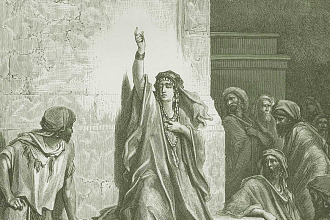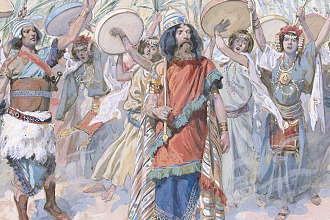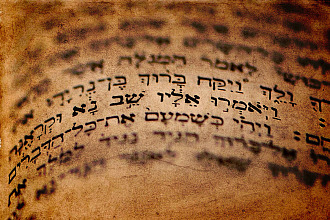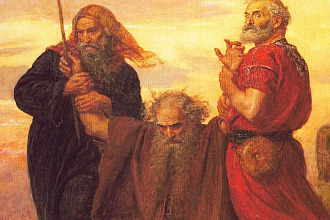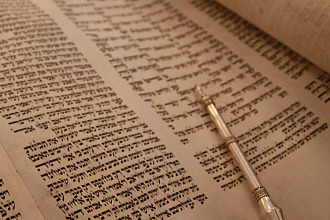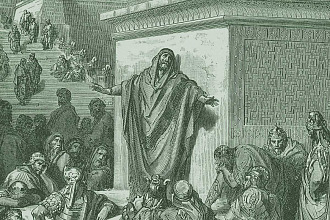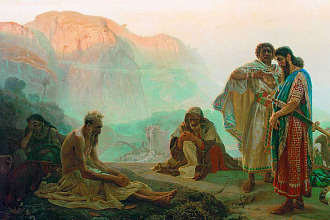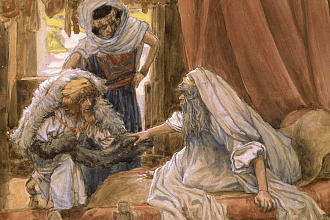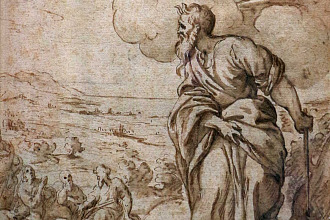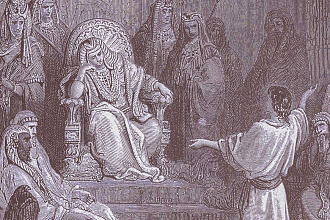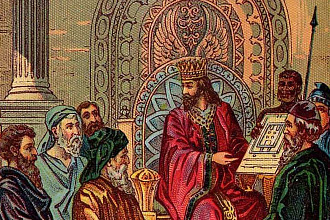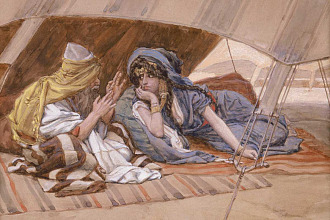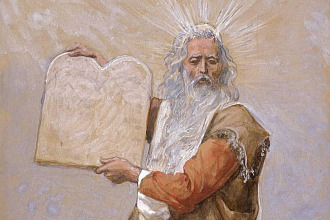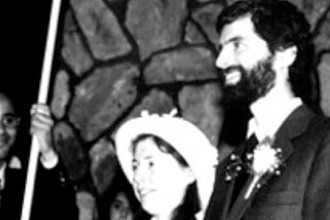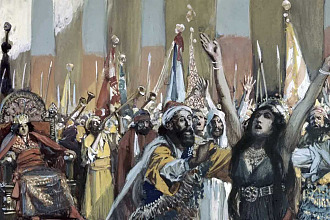This lesson is about the first Jewish temple ever built. In our last lesson we learned how the life of our great leader, Moses, prefigured the Messiah, our deliverer, in fifteen different ways (points A-O).
In this lesson we will see eleven more points (P-Z) showing how the first Jewish Temple, like the life of Moses, prefigured the Messiah, the hope of all Israel!
When the Jewish people left Egypt they were led to Mount Sinai. God called Moses up onto the mountain to be with Him for forty days. On Mount Sinai God gave Moses the Ten Commandments and the pattern for building the temple. The temple is also called the sanctuary, mishkan, or tabernacle.
In the lessons thus far we have primarily focused on people and on one of the lessons learned from their lives. (Abraham taught us about faith in God. Jacob taught us about repenting for mistakes we have made. From Joseph we learned the important lesson of forgiveness. And from Moses we started to learn about righteousness and the Messiah). Since the temple is mentioned in the Torah as well as in many other books of the Bible, in this lesson we will be reading from the writings of these other Jewish authors in addition to the writings of Moses.
1. How did Moses know how to make the sanctuary?
The LORD spoke to Moses, saying:...“Exactly as I show you—the pattern of the Tabernacle and the pattern of all its furnishings—so shall you make it.” Exodus 25:1, 9
Moses and the people built the Tabernacle, but God was the architect. The pattern was a heavenly pattern.
2. What was Moses to build inside this sanctuary, or tabernacle?
They shall make an ark of acacia wood,... Overlay it with pure gold. Exodus 25:10, 11
3. What was to be inside this distinctive ark?
“And deposit in the Ark [the tablets of] the Pact which I will give you... When He finished speaking with him on Mount Sinai, He gave Moses the two tablets of the Pact, stone tablets inscribed with the finger of God.” Exodus 25:16-21; 31:18
The Ten Commandments were so special they were placed inside the Ark of the of the Pact, the Ark of the Covenant.
4. What was one of God’s purposes for His temple or sanctuary?
And let them make Me a sanctuary that I may dwell among them. Exodus 25:8
God used the sanctuary as a demonstration that He wants to dwell with us. What a beautiful thought, that God wants to be with us! Our God is not some far off God, but one that is close at hand. He is with us in our times of joy and laughter as well as with us in our times of pain and sorrow. The Hebrew term “Emmanuel,” “God with us” invokes a sense of comfort and hope. He is with you right now as you are reading this lesson. To reveal a God who is close, loving, and compassionate is one of the purposes for the sanctuary as well as one of the purposes of the Messiah.
5. Where, in this beautiful sanctuary, would God meet with us?
“There I will meet with you, and I will impart to you—from above the cover, from between the two cherubim that are on top of the Ark of the Pact.” Exodus 25:22
This section of God’s Tabernacle was called the Most Holy Place. The top part of the Ark of the Covenant was called the Mercy Seat. It was here, between two gold angels that God would meet with us. God’s Mercy Seat sat above His Law. In the Psalms it says “mercy and truth are met together…have kissed each other” (Psalm 85:10). It is here, in God’s Most Holy Place, that mercy and truth, love and law, grace and judgment, are blended together in harmony.
6. What are the other five significant pieces of furniture that God directed Moses to build?
You shall make a table… And on the table you shall set the bread of display...You shall make a lampstandof pure gold... Make its seven lamps…to give the light on its front side…You shall make an altar for burning incense. Make a laver of copper...for washing... Put water in it... He made the altar for burnt offering. Exodus 25:23,30; 31,37; 30:18, 19; 38:1
Each piece of furniture in God’s Temple was designed by God after the heavenly pattern to teach us more about God’s love for us. The altar for burnt offerings was where we sacrificed animals in order to receive forgiveness of sins. (We will elaborate on this event in question 8). The laver for washing symbolized the cleansing from the guilt and defilement of sin that God does in our lives after we receive His forgiveness. The lampstand, or menorah, demonstrates God’s continual light shining in our life guiding and directing us. King David refers to God’s Word as a lamp for our feet. The table and the bread of display depict God’s provision to us and His desire that we ingest, internalize His truths into our lives. The altar for burning incense was where the Levites would pray for the children of Israel. This reminds us to be continually praying for each other.
7. Where did the Israelites get the materials to build God’s holy sanctuary?
Men and women, all whose hearts moved them, all who would make an elevation offering of gold to the Lord, came bringing brooches, earrings, rings, and pendants—gold objects of all kinds. Exodus 35:21,22
God designed the Temple, but we built it and paid for it from the finances God provided for us. The Egyptians gave us jewelry in their desire to get rid of us after all the plagues God brought upon them. We gave the jewelry to God for the building and upkeep of His temple.
8. What was the sanctuary primarily used for?
If any person... incurs guilt by doing any of the things which by the Lord’s commandments ought not to be done, and he realizes his guilt—or the sin of which he is guilty...he shall bring a female goat without blemish as his offering for the sin of which he is guilty. He shall lay his hand upon the head of the sin offering, andthe sin offering shall be slaughtered at the place of the burnt offering. The priest shall take...some of its blood and put it on the horns of the altar of burnt offering; and all the rest of its blood he shall pour out at the base of the altar…Thus the priest shall make expiation for him, and he shall be forgiven.Leviticus 4:27-31
The main daily activity that took place in the first Jewish temple was the sacrificing of animals as substitutes for the sins of the people. We saw in lesson one, when Abraham was about to sacrifice his son Isaac, God provided a ram caught in the thicket of a bush to be used as a substitute for Abraham’s son. It was through the sacrificing of the animal for our sins that we received forgiveness. It is not that God enjoyed the slaughtering of animals, but they, like the life of Moses, and the rest of the temple, were pre-figuring the life and work of the Messiah. Isaac asked his father, “Where is the sheep for the offering?” Abraham said, “God will see to the sheep for His offering.” God provided His own offering by providing the Messiah for us.”
9. According to Moses and the Torah is there any way to receive expiation—cleansing from and forgiveness for sins—without having to shed blood?
“The life of the flesh is in the blood, and I have assigned it to you for making expiation for your livesupon the altar; it is the blood, as life, that effects expiation.” Leviticus 17:11
A blood sacrifice was the only way that God prescribed for us to receive forgiveness of sins. This was the difference between Cain’s and Abel’s sacrifices. Two of Adam and Eve’s many children were Cain and Abel. Cain offered God a sacrifice of fruits and vegetables and Abel gave God the sacrifice He had asked for, a lamb. Cain’s sacrifice did not contain blood and it was not accepted, while Abel’s was a blood sacrifice and God accepted it. (Again, it is not that God wants the shedding of blood, but sin is so serious that it demands death. God’s law and righteousness requires either the death of the sinner or an acceptable substitute that God prescribes). Here again we see the work of the Messiah being foreshadowed.
Point P: Messiah would die as a sacrifice for the forgiveness of our sins, symbolized by the lambs in the sanctuary.
10. According to the book of Psalms, how many of us need this expiation—cleansing from and forgiveness for sins?
All have turned bad, altogether foul; there is none who does good, not even one. Psalm 14:3
Not one of us is perfect, not even one. We have all made mistakes; we all need God’s forgiveness and cleansing of our records and consciences.
11. The Hebrew prophet Isaiah used the illustration of the sacrifices of lambs and goats to represent the work of the Messiah being our sacrificial substitute.
He was despised, shunned by men, A man of suffering… We held him of no account. Yet it was our sickness that he was bearing, our suffering that he endured. We accounted him plagued, smitten and afflicted by God; but he was wounded because of our sins, crushed because of our iniquities. He bore the chastisement that made us whole, and by his bruises we were healed. We all went astray like sheep, each going his own way; and the Lord visited upon him the guilt of all of us. He was maltreated, yet He was submissive, He did not open his mouth; like a sheep being led to slaughter… For He was cut off from the land of the living through the sin of my people, who deserved the punishment. And his grave was set among the wicked, and with the rich, in his death—though He had done no injustice and had spoken no falsehood… He made himself an offering for guilt, He might see offspring and have long life, and that through him the Lord’s purpose might prosper. Out of his anguish He shall see it; He shall enjoy it to the full through His devotion. “My righteous servant makes the many righteous, it is their punishment that He bears; I will give Him the many as His portion, He shall receive the multitude as his spoil. For He exposed Himself to death and was numbered among the sinners, whereas He bore the guilt of the many and made intercession for sinners.” Isaiah 53:3-12
Point Q: We held Him of no account.
Point R: His grave was with the wicked and the rich.
Point S: He would be raised from the dead to see offspring and have long life.
Point T: He had done no injustice and had spoken no falsehood.
12. How can I receive forgiveness for my sins?
Confess my sins to the Messiah just as they did with the sheep in the sanctuary temple.
13. What incredible sign did God give the prophet Isaiah to tell us about the Messiah?
“Assuredly, my Lord will give you a sign of His own accord! Look, the young woman is with child and about to give birth to a son. Let her name him Immanuel.” Isaiah 7:14
Many scholars interpret young in the sense that she was still a virgin. If the young woman mentioned here was merely a young lady giving birth to a child this would not be much of a sign from God. The Hebrew word used here is עלמה (almah). עלמה Almah is often translated as virgin instead of as young woman. (See Genesis 24:43, 16.) Is it possible for a virgin to give birth? Remember, God gave Abraham and Sarah a miraculous child, Isaac, after Sarah was long past childbearing age. Nothing is impossible for God.
The word “Immanuel” used in this text means “God with us.” In question 5 we read that God told Moses that His being with us was one of the purposes of the sanctuary. Once again, we are shown how the sanctuary represented the Messiah. This miraculous Son, who would be a “sign” from God, would be born of a virgin and would be known as “God with us.” When the sanctuary was originally made it was placed right in the center of all the tribes of Israel. God wants to be in the center of our lives, He wants to be with us.
Point U: Messiah would be born of a virgin as a sign from God to us.
Point V: Messiah would be Immanuel, “God with us.”
14. What did the Jewish prophet Isaiah tell us about this extraordinary son?
For a child has been born to us, A son has been given us. And authority has settled on his shoulders. He has been named “The Mighty God is planning grace; The Eternal Father, a peaceable ruler.” Isaiah 9:5
15. In what town was this young woman to give birth to this remarkable child who would be “God with us”?
“And you, O Bethlehem of Ephrath, Least among the clans of Judah, From you one shall come forth to rule Israel for Me—One whose origin is from of old.” Micah 5:1
Point W: Messiah would be born in the town of Bethlehem.
16. Do we have other examples from the Torah where God took human form and lived among us?
Jacob was left alone. And a man wrestled with him... Said the other, “What is your name?” He replied, “Jacob.” Said he, “Your name shall no longer be Jacob, but Israel, for you have striven with God and man [margin], and have prevailed.” …So Jacob named the place Peniel, meaning, “I have seen a divine being face to face, yet my life has been preserved.” Genesis 32:25-31
Peniel literally means face of God. Jacob wrestled face to face with God while God was veiling Himself as a man. When Jacob realized it was God he had wrestled with he called the place Peniel—face of God. Another example is when God appeared to Abraham as a man (see Genesis 18:1, 2).
Point X: He would be the Messiah, yet He would dwell with us as a man.
17. In what way did King David prophesy that our Messiah would die?
“My life ebbs away: all my bones are disjointed; my heart is like wax, melting within me; my vigor dries up like a shard; my tongue cleaves to my palate; You commit me to the dust of death...a pack of evil ones closes in on me, like lions [they maul] my hands and feet. I take the count of all my bones while they look on and gloat. They divide my clothes among themselves.” Psalm 22:15-18
It is amazing that King David described this form of death caused by being pierced and hung by the hands and feet. This cruel form of execution used by the Romans was not invented until hundreds of years after King David wrote this prophecy.
Point Y: In His death His bones would come out of joint.
Point Z: His hands and His feet would be mauled.
18. Which eternal scar does God specifically mention, to remind us that God can never forget us because of the sacrifice of the Messiah as our substitute?
I never could forget you. See, I have engraved you on the palms of My hands... Isaiah 49:15, 16
When the Messiah’s hands were nailed to the wood for our sins He engraved our names upon His heart God’s love for you is deep and eternal, He will never forget you. What a loving God we have.
19. Many people believe these verses from the Hebrew Scriptures about the Messiah describe the life and death of a Jewish man named Y’shua. Let’s see if there is any credibility to this view by first reviewing the fifteen ways Moses’ life prefigured the Messiah and then looking at the eleven identifying points we read from God’s word today:
A: Like Moses the Messiah was miraculously saved from death as a baby.
B: He was called by God to deliver His people out of bondage.
C: He led the people to worship God.
D: He performed miracles.
E: He was rejected by many of the people He tried to save.
F: He fasted in the wilderness forty days and nights.
G: He promoted the law of God to the people.
H: He interceded for the people’s sins.
I: He was willing to die in place of those who sinned.
J: He beheld God’s presence.
K: He was humble.
L: He did God’s will and not His own; following God’s leading.
M: He was a prophet.
N: He spoke God’s words in God’s name.
O: People were accountable for following what He said.
P: He would die as a sacrifice for the forgiveness of our sins, symbolized by the lambs in the sanctuary.
Q: We held Him of no account.
R: His grave was with the wicked and the rich.
S: He would be raised from the dead to see offspring and have long life.
T: He had done no injustice and had spoken no falsehood.
U: He would be born of a virgin as a sign from God to us.
V: He would be Immanuel “God with us.”
W: He would be born in the town of Bethlehem.
X: He would be the Messiah, yet He would dwell with us as a man.
Y: In His death His bones would come out of joint.
Z: His hands and His feet would be mauled.
The chances of all 26 of these identifications, from A to Z, to be fulfilled in one individual are almost impossible. But with a little knowledge of history it can be seen that from A to Z the Jewish Messiah prophesied in the Hebrew Scriptures is Y’shua! (Y’shua in Hebrew means Saviour. Y’shua was how His Jewish parents pronounced His name) (If you would like to read how His life fulfilled these prophecies, you can examine it for yourself in the Holy Bible under the sections entitled Matthew, Mark, Luke, and John.) Jewish people who accept that these Biblical prophecies point to Y’shua as the Messiah do not stop being Jewish. You merely become a Jewish person who knows who his Jewish Messiah is. And then having accepted Him as your Messiah you can accept His death for the forgiveness and expiation for the sins you have committed. Y’shua becomes your substitute, carrying your burden of guilt and shame. Through that Divine forgiveness and acceptance with God you have the assurance of eternal life with God.
Although the Messiah has been misrepresented many times by those who profess to follow Him, He is very Jewish. He was circumcised on the 8th day, kept the Passover and all the Jewish Holy Days, and He regularly attended services in the synagogues on Sabbath. He loved the God of Abraham, Isaac, and Jacob, and He kept the 10 commandments perfectly. He never was anti-Semitic and he never encouraged anyone else to be, either. Even though He died as the sacrificial lamb approximately 2,000 years ago, His life has been prolonged, as the scripture in question 11 prophesied. He is alive in Heaven today and He loves you.
We must have more than just an intellectual understanding of the prophecies. You and I need to accept Him, Y’shua, as the sacrifice for our mistakes in order to receive the forgiveness of our sins that He died for.
Right now confess your mistakes to Him; thank Him for dying for you, thank Him for giving you forgiveness. Ask Him to dwell with you, to give you peace and joy in your life. Ask Him to enter your mind, and meet your temptations in your human flesh for you! Receive His victory as your own. You will be glad you did.
Have you ever wondered where the terms Hebrew, Jew, or Israelite come from? You will find out in your next study. You will also find out who is the most influential Jewish person in all history. Complete this Review sheet right away and go on to your next exciting lesson entitled, “A Nice Jewish Boy.”
This lesson is adapted from "Jewish Discoveries," by Jeff Zaremsky, to buy the printed book, click here.

